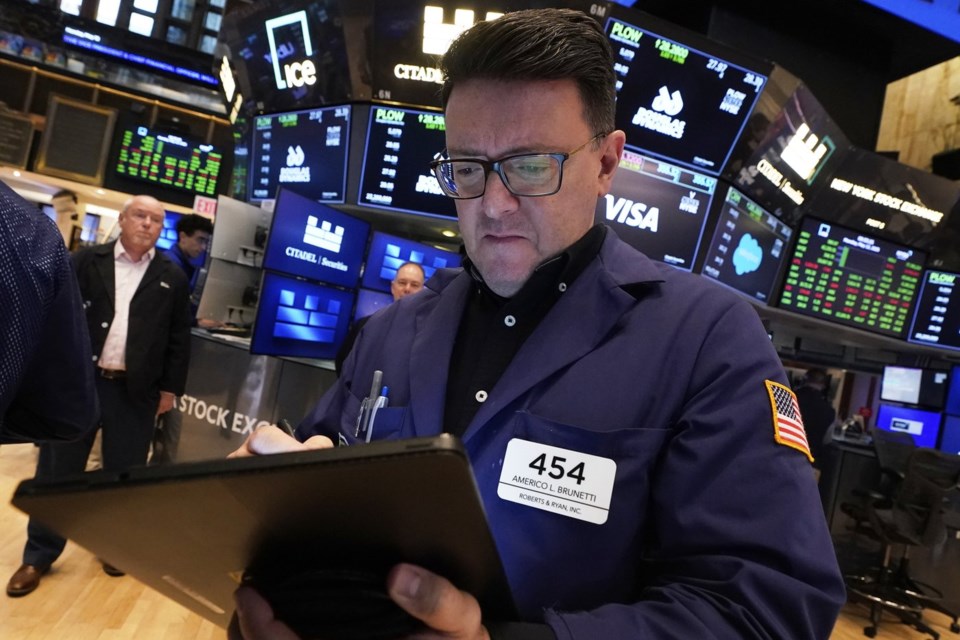NEW YORK (AP) — Stocks rallied Monday after China and the United States announced a 90-day truce in their trade war. Each of the world’s two largest economies agreed to take down temporarily most of its tariffs against the other, which economists had warned could start a recession and create shortages on U.S. store shelves.
The S&P 500 shot up 3.3% to pull back within 5% of its all-time high set in February. It’s been roaring higher since falling nearly 20% below the mark last month on hopes that President Donald Trump will lower his tariffs after reaching trade deals with other countries. The index at the heart of many 401(k) accounts is back above where it was on April 2, Trump’s “Liberation Day,” when he announced stiff worldwide tariffs that ignited worries about a potentially self-inflicted recession.
The Dow Jones Industrial Average jumped 1,160 points, or 2.8%, and the Nasdaq composite climbed 4.3%.
It wasn’t just stocks rising following what one analyst called a “best case scenario” for US-China tariff talks, which reduced tariffs by more than what many investors expected.
Crude oil prices climbed because a global economy less burdened by tariffs will likely burn more fuel. The value of the U.S. dollar strengthened against everything from the euro to the Japanese yen to the Swiss franc. And Treasury yields jumped on expectations that the Federal Reserve won’t have to cut interest rates as deeply this year as earlier expected in order to protect the economy from the damage of tariffs.
Gold’s price fell, meanwhile, as investors felt less need to buy something safe.
The move announced Monday could add 0.4 percentage points to the U.S. economy’s growth this year, according to Jonathan Pingle, U.S. chief economist at UBS. That’s a significant chunk, and every bit counts when the U.S. economy shrank at a 0.3% annual rate in the first three months of the year.
The United States said in a joint statement that it will cut tariffs on Chinese goods to 30% from as high as 145%. China, meanwhile, said its tariffs on U.S. goods will fall to 10% from 125%. The 90-day pause gives time for more talks following the weekend’s negotiations in Geneva, Switzerland, which the U.S. side said yielded “ substantial progress.”
The 90-day reprieve also comes at a vital time for the economy, allowing retailers and suppliers to “ensure that shelves are stocked for the all important back-to-school and holiday shopping seasons,” said Carol Schleif, chief market strategist at BMO Private Wealth.
Of course, conditions could change quickly again, as Wall Street has seen all too often in Trump’s on-again-off-again rollout of tariffs. Big challenges still remain in the negotiations between China and the United States, and there is “no reason to believe that this will be anything other than a slow process,” said Scott Wren, senior global market strategist at Wells Fargo Investment Institute.
The U.S.-China pause followed a deal the United States announced last week with the United Kingdom that will bring down tariffs on many U.K. imports to 10% but will still require weeks to finalize all the details.
Economic reports scheduled for later this week, including on inflation and sentiment among U.S. consumers, could also show how much damage the U.S. economy has already taken because of uncertainty about tariffs. But the mood was nevertheless ebullient across Wall Street on Monday, and gains were widespread.
Stocks of smaller companies rallied. Their livelihoods can be more dependent on the strength of the U.S. economy than their bigger and more insulated rivals, and the smaller stocks in the Russell 2000 index jumped 3.4%.
Apparel companies were also strong. Lululemon leaped 8.7%, for example. More than a quarter of its fabric came from mainland China last fiscal year, and a reduction in tariffs would mean a less-tough decision on whether to pass along increases to costs to customers or to eat them through reduced profits. Nike rose 7.3%.
Travel companies jumped on hopes that lower tariffs would encourage more customers to feel comfortable enough to spend on trips. Carnival rose 9.6%, and Delta Air Lines climbed 5.8%.
Many retailers rose because much of what they sell comes from China and elsewhere in Asia. Best Buy jumped 6.6%, and Amazon rallied 8.1%.
All told, the S&P 500 rose 184.28 points to 5,844.19. The Dow Jones Industrial Average gained 1,160.72 to 42,410.10, and the Nasdaq composite leaped 779.43 to 18,708.34.
In stock markets abroad, indexes rose across most of Europe and Asia, though often by less than the U.S. market.
In the bond market, the yield on the 10-year Treasury jumped to 4.47% from 4.37% late Friday.
The two-year Treasury yield, which more closely tracks expectations for what the Fed will do with interest rates, jumped even more. It rose to 4.00% from 3.88% as traders ratcheted back expectations for how many cuts to interest rates the Fed may deliver this year.
Many traders are now betting on just two cuts this year, according to data from CME Group.
____
AP Business Writers Matt Ott, Jiang Junzhe and Elaine Kurtenbach contributed.
Stan Choe, The Associated Press



